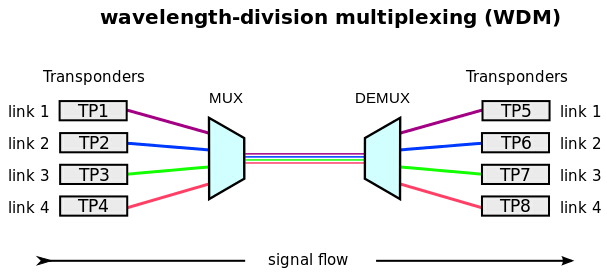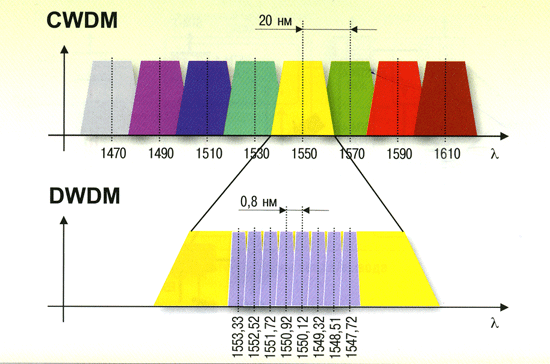In fiber-optic communications, WDM (wavelength-division multiplexing) is a technology which multiplexes a number of optical carrier signals onto a single optical fiber by using different wavelengths (i.e., colors) of laser light. This technique enables bidirectional communications over one strand of fiber as well as multiplication of capacity. Generally, WDM technology is applied to an optical carrier which is typically described by its wavelength.
WDM system uses a multiplexer at the transmitter to join the signals together, and a demultiplexer at the receiver to split the signals apart (see Figure 1). WDM system is very popular in the telecommunication industry because it allows the capacity of the network to be expanded without laying more fiber. By utilizing WDM and optical amplifiers, users can accommodate several generations of technology development in their optical infrastructure without having to overhaul the backbone network. Moreover, the capacity of a given link can be expanded simply by upgrading the multiplexers and demultiplexers at each end.

Figure 1
WDM could be divided into CWDM (coarse wavelength division multiplexing) and DWDM (dense wavelength division multiplexing). DWDM and CWDM are based on the same concept of using multiple wavelengths of light on a single fiber but differ in the spacing of the wavelengths, number of channels, and the ability to amplify the multiplexed signals in the optical space. Below part will introduce some differences between CWDM and DWDM system.
CWDM provides 8 channels with 8 wavelengths (from 1470nm through 1610nm) with a channel spacing of 20nm. While DWDM can accommodate 40, 80 or even 160 wavelengths with narrower wavelength spans which are as small as 0.8nm, 0.4nm or even 0.2nm (see Figure 2).

Figure 2
DWDM multiplexing system is capable of having a longer haul transmittal by keeping the wavelengths tightly packed. It can transmit more data over a larger run of cable with less interference than CWDM system. CWDM system cannot transmit data over long distance as the wavelengths are not amplified. Usually, CWDM can transmit data up to 100 miles (160km).
The power requirements for DWDM are significantly higher. For instance, DWDM lasers are temperature-stabilized with Peltier coolers integrated into their module package. The cooler along with associated monitor and control circuitry consumes around 4W per wavelength. Meanwhile, an uncooled CWDM laser transmitter uses about 0.5W of power.
The DWDM price is typically four or five times higher than that of the CWDM counterparts. The higher cost of DWDM is attributed to the factors related to the lasers. The manufacturing wavelength tolerance of a DWDM laser die compared to a CWDM die is a key factor. Typical wavelength tolerances for DWDM lasers are on the order of ±0.1 nm, while tolerances for CWDM laser die are ±2-3 nm. Lower die yields also drive up the costs of DWDM lasers relative to CWDM lasers. Moreover, packaging DWDM laser die for temperature stabilization with a Peltier cooler and thermister in a butterfly package is more expensive than the uncooled CWDM coaxial laser packing.
To sum up, CWDM and DWDM have different features. Choosing CWDM or DWDM is a difficult decision. We should first understand the differences between them. Fiberstore has various kinds of WDM products, such as 10GBASE DWDM, 40 channel DWDM Mux, CWDM Mux/Demux module and so on. It is an excellent option for choosing CWDM and DWDM equipment.
Learn more details about CWDM and DWDM SFP+ transceivers at Everything You Need to Know Before Buying CWDM and DWDM SFP+ Transceivers
Related Article: The Advantages and Disadvantages of Multimode and Single-mode Fiber
